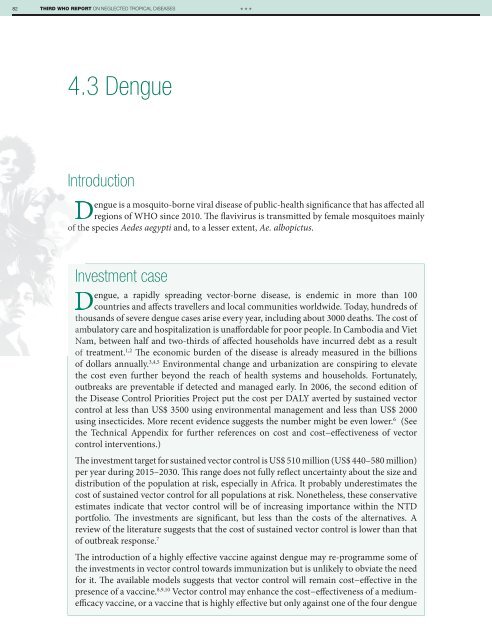1A9bnbK
1A9bnbK
1A9bnbK
Create successful ePaper yourself
Turn your PDF publications into a flip-book with our unique Google optimized e-Paper software.
82 THIRD WHO REPORT ON NEGLECTED TROPICAL DISEASES<br />
***<br />
4.3 Dengue<br />
Introduction<br />
Dengue is a mosquito-borne viral disease of public-health significance that has affected all<br />
regions of WHO since 2010. The flavivirus is transmitted by female mosquitoes mainly<br />
of the species Aedes aegypti and, to a lesser extent, Ae. albopictus.<br />
Investment case<br />
Dengue, a rapidly spreading vector-borne disease, is endemic in more than 100<br />
countries and affects travellers and local communities worldwide. Today, hundreds of<br />
thousands of severe dengue cases arise every year, including about 3000 deaths. The cost of<br />
ambulatory care and hospitalization is unaffordable for poor people. In Cambodia and Viet<br />
Nam, between half and two-thirds of affected households have incurred debt as a result<br />
of treatment. 1,2 The economic burden of the disease is already measured in the billions<br />
of dollars annually. 3,4,5 Environmental change and urbanization are conspiring to elevate<br />
the cost even further beyond the reach of health systems and households. Fortunately,<br />
outbreaks are preventable if detected and managed early. In 2006, the second edition of<br />
the Disease Control Priorities Project put the cost per DALY averted by sustained vector<br />
control at less than US$ 3500 using environmental management and less than US$ 2000<br />
using insecticides. More recent evidence suggests the number might be even lower. 6 (See<br />
the Technical Appendix for further references on cost and cost−effectiveness of vector<br />
control interventions.)<br />
The investment target for sustained vector control is US$ 510 million (US$ 440–580 million)<br />
per year during 2015–2030. This range does not fully reflect uncertainty about the size and<br />
distribution of the population at risk, especially in Africa. It probably underestimates the<br />
cost of sustained vector control for all populations at risk. Nonetheless, these conservative<br />
estimates indicate that vector control will be of increasing importance within the NTD<br />
portfolio. The investments are significant, but less than the costs of the alternatives. A<br />
review of the literature suggests that the cost of sustained vector control is lower than that<br />
of outbreak response. 7<br />
The introduction of a highly effective vaccine against dengue may re-programme some of<br />
the investments in vector control towards immunization but is unlikely to obviate the need<br />
for it. The available models suggests that vector control will remain cost−effective in the<br />
presence of a vaccine. 8,9,10 Vector control may enhance the cost−effectiveness of a mediumefficacy<br />
vaccine, or a vaccine that is highly effective but only against one of the four dengue


